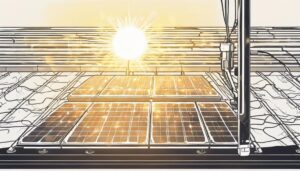As you navigate the winding road of sustainable energy solutions, understanding the true cost of solar panels is akin to finding a hidden trailhead, it’s the first step on a journey that could lead to significant savings. You’ve likely heard the sales pitches promising free electricity and huge tax breaks, but before you leap at the chance to harness the sun’s power, it’s crucial to dissect the initial investment, the breakdown of installation costs, and the reality of government incentives.
You should also weigh the ongoing maintenance expenses against the projected savings on your energy bills. These financial considerations are the compass that’ll guide you toward a decision that aligns with both your environmental goals and your budget.
As we unpack the layers of solar panel pricing, you’ll discover the nuances that determine whether going solar is a bright idea for your particular situation.
Listen To The Summary
Initial Investment for Solar Panels
Understanding the initial investment for solar panels is crucial, as you’ll find costs can vary widely based on size, type, and location, with average expenses ranging from $4,500 to $36,000. The upfront costs are influenced by numerous factors, including the cost of solar panels themselves and the installation costs. The system size plays a significant role in determining the price, with a standard 6-kW solar panel system offering a good benchmark for average cost comparisons.
As you delve into the specifics, remember that the cost to install a solar installation isn’t uniform across the board. State-by-state variations reflect differing local incentive programs and quoting trends, so it’s wise to research what applies to your locality. Also, the initial investment can be affected by the number of panels and their weight, which may influence the complexity of the installation.
Don’t overlook additional costs such as maintenance, cleaning, and potential insurance adjustments. These can impact your overall financial planning. Fortunately, financial institutions and companies like Tesla provide various financing options, including solar loans and leasing agreements, giving you flexibility with the initial investment. By understanding these variables, you’re better equipped to navigate the financial journey of going solar.
Breakdown of Installation Expenses
When investing in solar power, it’s essential to consider that the installation expenses encapsulate more than just the panels themselves; they also include costs for additional equipment, labour, and any potential modifications to your property. Understanding the breakdown of these costs can help you better anticipate your initial investment and the true cost of a solar system.
Here’s what you need to factor into your solar panel installation budget:
- Mounting Equipment: Brackets and supports for securing panels to your roof or ground mount.
- Labour Costs: Professional fees for installing solar panels and ensuring everything is up to code.
- System Cost Variability: The price fluctuates based on the size of the system needed to meet your electricity needs.
- Complex Roof Adjustments: If your roof has an unusual shape or steep incline, it can increase installation challenges and costs.
- Renewable Energy Incentives: Available tax credits and rebates that can significantly reduce the overall expense.
Government Incentives and Rebates
You’ve eyed the sticker price for solar panels, but did you know government incentives can make a substantial dent in your costs?
With a federal tax credit that slashes installation expenses by 30%, you’re looking at a much friendlier number.
Don’t overlook state-level programs either; they can offer additional financial breaks that make going solar even more appealing.
Federal Tax Credit Impact
Harnessing the sun’s power becomes significantly more affordable when you factor in federal tax credits, which can slash installation costs by as much as 26%. The Federal Tax Credit acts like a discount card for your solar energy system, directly lowering the cost come tax season. Here’s what you need to know:
- The solar tax credit can be applied to your tax bill, reducing the amount you owe dollar-for-dollar.
- Solar Incentives are available at both federal and state levels, compounding savings.
- The credit includes costs for the solar panels and associated installation.
- Excess credit may be carried over to the next tax year if it exceeds your tax liability.
- Understanding these tax credits is crucial to accurately calculate the true price of solar panels and energy production.
Don’t miss out on these savings; they’re key to making your solar transition economically attractive.
State-Level Incentive Programs
Beyond federal tax credits, your state’s unique incentive programs can further reduce the financial burden of switching to solar power. Various states offer enticing incentives, such as tax credits, cash rebates, and solar renewable energy credits (SRECs), all designed to make solar systems more accessible. These incentives are vital in the solar industry, supporting the transition to clean energy.
State Incentives for Renewables also include performance-based incentives (PBIs) and net metering, which can significantly offset your initial solar equipment costs. You’ll find that solar loans and other financing options are also available, often backed by the Department of Energy’s initiatives to promote solar power.
It’s essential to explore your state’s offerings, as they can greatly influence your solar installation’s affordability.
Ongoing Maintenance and Repair Costs
Maintaining your solar panel investment requires an annual expenditure of $280 to $720 for regular upkeep and cleaning, ensuring your system operates at peak efficiency. While solar panel costs can be upfront, ongoing maintenance and repair costs are equally crucial to consider. These costs can vary, but it’s vital to maintain your system to maximize the energy produced and keep your utility bill savings high.
Here’s what you need to know about the costs associated with maintaining solar systems:
- Regular Cleaning: Dirt and debris reduce efficiency; solar companies may offer cleaning services at approximately $25 per panel.
- Repairs: Occasionally, panels require repairs due to wear or damage, ranging from $300 to $1,300.
- Inspections: Annual inspections catch issues early, potentially saving you from costly repairs down the line.
- Tree Trimming: To prevent shading and ensure maximum sunlight exposure, expect to pay $250 to $700.
- Warranties: Some manufacturers offer warranties that might cover certain repairs, which can mitigate out-of-pocket expenses.
Projected Savings on Energy Bills
When considering the switch to solar energy, you’ll find that projected savings on your energy bills can be substantial, influenced by factors like your local electricity rates and personal energy consumption patterns. By reviewing your monthly electricity use and utility bills, you’ll get a clearer picture of your energy usage and the potential to save with solar.
Installing a solar panel system reduces your reliance on the grid, which means you can expect to see a decrease in your monthly utility bills. Plus, with a solar battery storage system, you can store excess energy for use when the sun isn’t shining, further cutting down on your electricity bill.
Here’s a glimpse of how solar can impact your finances:
|
Factor
|
Without Solar
|
With Solar
|
|---|---|---|
|
Monthly Electricity Bill
|
High
|
Reduced
|
|
Payback Period
|
None
|
Several Years
|
|
Energy Independence
|
Low
|
High
|
The 30% federal solar tax credit available through 2032 also plays a big role in the affordability of solar panels, boosting your projected savings on energy bills. Remember, the cost of solar and your eventual savings can vary significantly based on sunlight, regional incentives, and your specific electricity use.
Financing Solar Installations
As you consider the leap into solar energy, understanding your financing options is crucial. You’ll find that solar loans and government incentives can significantly reduce the initial costs, making this green investment more accessible.
Let’s compare the different loan types and unpack how government incentives can work in your favour.
Loan Types Compared
Exploring the various loan types for financing solar installations, you’ll find that each option comes with its own set of benefits and drawbacks tailored to different financial situations. When you’re delving into the solar panel’s cost, understanding the costs per watt and the price range is crucial. Here’s a breakdown to help you navigate:
- Solar loans: Offered by financial institutions, tailored to pay for solar panels with fixed repayment terms.
- Power Purchase Agreements (PPAs): You agree to a cost per watt with a third party, avoiding upfront costs.
- Leasing: Similar to PPAs, but typically involves a fixed monthly payment.
- Cash-out refinances Leverage your mortgage for lower interest rates.
- Home equity line of credit: Uses your home’s equity for a potentially lower final cost.
Make sure you weigh each option against the cost of your solar project to determine the best financial path for your residential solar investment.
Government Incentives Explained
Navigating the landscape of government incentives for solar installations can substantially lighten your financial load, making the transition to renewable energy both accessible and appealing. The Department of Energy’s policies and various state programs may help offset a significant portion of the total cost.
Let’s break it down: you can take advantage of federal tax credits that reduce your upfront expenses. Moreover, many utility companies offer rebates that put money back in your pocket. These rebates can vary greatly, with some potentially covering a considerable percentage of the panels depending on where you live.
Always factor in the cost of available incentives against the national average to gauge the true cost of your solar investment. By leveraging these incentives, you’re positioning yourself for a sunnier financial future.
Frequently Asked Questions
What Is the Average Cost of a 1 Solar Panel?
You’ll find the average cost of one solar panel influenced by installation factors, energy savings, and solar incentives. Panel efficiency, maintenance, roof compatibility, warranty terms, market trends, weather impact, and longevity also affect pricing.
What Is the Truth Behind No Cost Solar Panels?
You might’ve heard of no-cost solar panels, but beware of hidden fees and read contract terms carefully. Solar incentives and energy savings can offset upfront investment, but maintenance costs and installation deals vary.
How Much Does a Solar Panel Cost on Average About $16000 or Between $3500 to $35000 Depending on the Type and Model?
You’re looking at an average solar panel cost of $16,000, but it varies from $3,500 to $35,000 influenced by efficiency ratings, installation fees, and type. Consider solar incentives, maintenance costs, and warranty coverage.
Are Solar Panels Worth the Expense?
If you’re considering solar panels think sustainable investment. They offer energy independence, lower grid reliance, and renewable benefits. Remember efficiency rates, maintenance costs, and resale value. Government incentives help reach the break-even point despite climate impact concerns.
Conclusion
You’ve seen that solar panel costs aren’t just about the initial price tag. From installation to incentives, and upkeep to energy savings, there’s a lot to consider.
By weighing these factors, you can make a savvy investment that not only cuts down your energy bills but also benefits the planet. Remember, financing options are there to help you manage the costs.
So, take the leap, harness the sun’s power, and watch your investment pay off in the long run.



